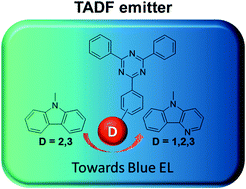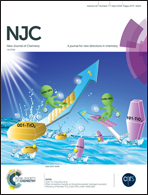Blue thermally activated delayed fluorescence emitters with a δ-pyridoindole donor moiety†
Abstract
Three blue thermally activated delayed fluorescence (TADF) emitters containing a δ-pyridoindole donor moiety and diphenyltriazine acceptor moiety were designed, synthesized and characterized using photophysical and electroluminescence studies. Their photophysical properties and device performances were compared with those of control materials comprising a carbazole donor moiety. The functional properties were altered by different numbers and linking position of the δ-pyridoindole donor moiety. The δ-pyridoindole-substituted materials exhibited blue-shifted emissions and low-lying HOMO levels when compared to their control materials. The as-fabricated OLED devices based on these TADF emitters with a δ-pyridoindole donor demonstrated the blue electroluminescence property with maximum external quantum efficiency of 22.1% and CIE color coordinates of (0.16, 0.23). This result showed that heteroatom engineering in the molecular skeleton is an effective way towards designing highly efficient blue TADF emitters.



 Please wait while we load your content...
Please wait while we load your content...